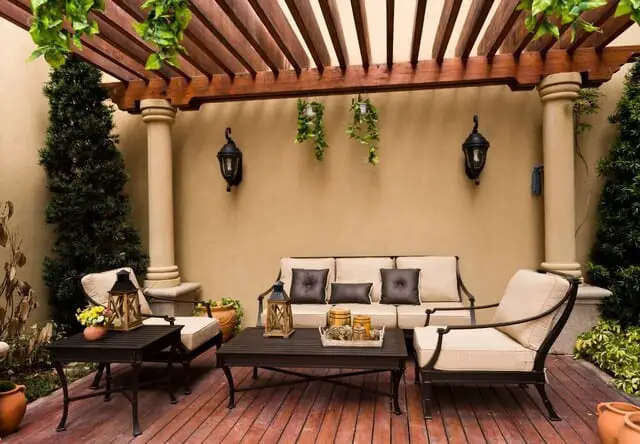Adding a deck or a patio to your home is a great way to add value to your home and extend your living and entertaining space to include some of the outdoors. Often, this option is considered in places where there are long hot summers, but this poses some complications for your outside area. The hot sun can make your deck or patio scorching hot, to the point that you cannot use it as much as you would like to. So how do you keep your deck or patio cool in the hot summer sun?
11 ways to prevent heat on your deck or patio.
- Choose the right material.
- Use lighter colors.
- Add a roof covering.
- Don’t block the breeze.
- Use existing shade.
- Use water, like ponds, fountains, or misters.
- Get an outdoor carpet.
- Get the air moving.
- Use plants.
- Create your own shade.
- Pick the right deck furniture.
Keeping your deck and patio cool when the weather is hot is the key to getting the most out of your outdoor space. Being able to enjoy the outdoors as part of your living space has advantages. Suppose you are currently designing and planning your deck or patio. In that case, there are design components you can include to beat the heat below. If you already have your outdoor area, you can implement changes and strategies to cool your patio or deck down on hot days.
How To Prevent Your Deck From Getting Hot
To prevent your deck or patio from becoming unbearably hot in the middle of summer, take these steps right from the beginning. Then, in the design phase, you can choose materials and colors that will be cooler.
Suppose you already have an existing outside area you are looking to make cooler in the summertime. In that case, there are many different options open to you. Most will work well and add a new aesthetic dynamic to your outdoors as well.
We will start off by considering the options you can choose from the beginning, the design time. These will influence the temperature on your deck or patio. Then we will work our way over to what you can do if you are trying to cool a preexisting outdoor area.
Which Is Cooler; Wood, Composite, Or Concrete
Choosing a material that will absorb less heat is a good foundation for your patio or deck. Thus, preventing heat buildup and scorching hot floors that you cannot even walk barefoot on.
Different materials absorb heat differently and will, thus, be either cooler or hotter to the touch after being in the baking sun.
You should factor the heat aspect of your chosen material into the equation and not only on the aesthetics that the material will bring to your outside space. For example, it is no good if your deck or patio looks stunning but is too hot to use!
1. Choose The Right Material
Choosing the right material will help to maintain cooler temperatures on your deck or patio. Your choices are primarily natural materials such as wood, stained in different colors, composite materials, or concrete.
- Natural wood materials. The advantage of wood as the floor material is that it absorbs the heat deep into the wood, which keeps the outer surface of the wood cool. As the air temperature decreases, the heat will be released back to the surface. This means that the wood will be cool during the day but remain warm longer into the evening. Ipe is a dense hardwood from Brazil that is an excellent choice because it does not retain much heat. Other good choices are Redwood and Cedar. Treated Yellow Pine is a great softwood choice, and the light color of the wood absorbs very little heat.
- Composite materials. Composite materials become hotter to the touch than natural wood and could be too hot to walk on if heated by the sun. However, the advantage of composite materials is that they cool down much faster than wood when they are shaded. Therefore, if you can provide shading for your deck, it would be cooler to the touch than wood. Choosing a lighter-colored composite material will also help to reduce its heat absorption.
- Concrete material. Concrete is probably the hottest of the deck and patio materials. It will quickly become too hot to walk on when subjected to the prolonged hot sun. If your outside space is subjected to a lot of direct sunlight for a large part of the day, concrete is probably not the best option. Concrete will also radiate the absorbed heat out during the evening, making the outside area feel warmer. This may be what you want in winter or on a cooler day, but not in the middle of the summer heat. If the floor of your deck or patio is made from concrete, you will need to put other measures in place to cool it down.
2. Colors To Choose For Your Deck Or Patio
Color can play a surprisingly significant role in the heat absorption of your outside area and affect how comfortable the temperature will be.
Lighter colors absorb less heat and do reflect more of the sun’s heat away from the surface of the deck or patio.
Rule of thumb, black is the absorption of all colors, and white is the reflection of all colors. So while heat energy can be outside the visible light spectrum, it does, however, tend to reflect off of lighter color shades as well.
If you intend to install a composite material for the floor, going with a lighter color will reduce the heat absorption and reduce the temperature to the touch.
For wooden decks, darker woods will be warmer to the touch than lighter colored decks, so don’t stain your decking too dark. Using a lighter-colored wood such as Cedar or even treated Yellow Pine will help to reduce the temperature of the deck.
If your floor is made from concrete, a coat of light-colored porch & deck paint can spruce up and brighten your outside area and reduce the amount of heat that the concrete will absorb from the sun. However, don’t paint the concrete too light as it may reflect a lot of light, and it will be too dazzling to be outside without sunglasses in the midday sun.
The outside walls of your house that are in the deck or patio area can also be painted a lighter color that will help to lighten the area and also reflect heat rather than absorb it.
3. Add A Roof Covering To The Deck Or Patio
Of course, you don’t want to completely enclose your outside area with a solid roof; otherwise, it simply becomes another room rather than an outdoor space to enjoy!
The roof covering that we are talking about here is a slatted structure such as a pergola or gazebo-type structure, often called a deck canopy. These are slats of timber that are supported above the deck or patio on pillars and break up the sunshine that reaches the structure’s floor.
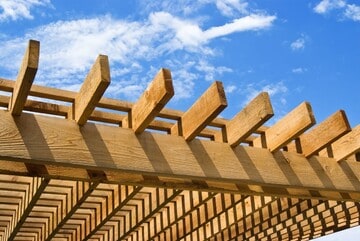
This can provide a cooling effect, and depending on the design of your house, it can enhance the visual appeal and décor of your home.
A roof-type structure like this will also offer you a support structure to add other cooling methods to your outside area that would not be possible without an overhead structure.
These roofing ideas can be incorporated as part of the design if building new or installed from a kit to add this type of structure (like a pergola) to an existing deck or patio. Here is our kit we like, easy to put together (with 2 people) and looked good when done, check it out here on Amazon.
4. Don’t Block The Wind
If you are designing your outside area, it is wise to step outside and check which direction your prevailing winds are coming from during that time of year.
You may also be at the coast, and you have a sea breeze that blows across your property. All these movements of air over your patio or deck surface will help to suck the heat out of the floor and cool the surface down. Just like blowing over the top of hot coffee!
Don’t build a privacy wall or a tall structure on the side of your outside area that will completely block the breeze that is helping to cool down your deck and garden area.
If the wind gets to be particularly strong in your location and you want a windbreak, consider an option that is not solid but serves to reduce the wind down to a comfortable velocity. These can be a section or two of a shadow box fence style or decorative plants and small trees. Even screen blocks or breeze blocks will do this job but still allow a gentle breeze to roll through your outdoor space to keep it cool without blowing you away.
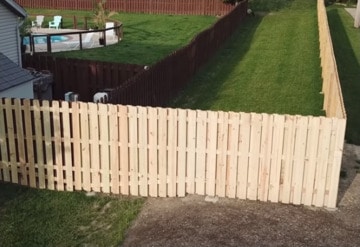
5. Use Existing Shade
If there is an existing shade in the area where you want to build your deck or patio, consider positioning the space so that you can use the existing shade. Covering a portion of the deck or patio area will give the best of both worlds.
A shade that covers a portion of your outside area will give you the option to sit in the full sun or to sit in the shaded area.
A partially shaded area will have an overall cooling effect on the outside area, even over the place that is in the full sun. The ideal situation will be if the tree will lose its leaves in the wintertime. This way, your deck or patio will have the warming effect of the winter sun and make it warmer at this time of year. (although who wants to rake leaves?)
What If Everything Is The Way You Want It, What Can You Do?
The options we have covered up till now have been measures that are most practical to consider if you are starting out and building a new deck or patio and can be incorporated into the design before the area is constructed.
If your area is already built the way you like it and you have chosen your materials for aesthetics and visual appeal. What can you do to your deck or patio in the middle of summer?
What options are available to you to adjust the heat of your outside area if you already have it built the way you want it?
Fortunately, there are a few options that we can investigate, some of which may even further enhance or at least accent the look of your outside area. Still, all of them will help to lower the temperature out there on the deck.
6. Use Water To Cool The Outside Area
Water is a very effective method of cooling down the surface of an outside area a well as reducing the air temperature, making it more comfortable to use the space in hot seasons.
If you just need to quickly cool the surface down so that it is more comfortable to walk on, you can use a hosepipe to hose down the surface. This will work really well for any floor surface for your outside area, but a concrete floor will quickly warm up again to the point that it is too hot to walk on barefoot.
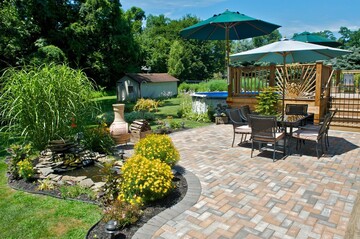
The disadvantage of this is that it does not last long, and you don’t want people walking into your house with wet feet. The water on the floor could also create a slipping hazard that could potentially cause injury should someone slip on the wet surface and fall down.
Fortunately, there are other methods of using water to cool down your outside area other than hosing it down every 30-minutes!
Installing a misting system is an effective method of cooling the air temperature on your deck or patio. The cooler air temperature will also cool down the floor, which means that you will be able t walk on it, and it will be radiating less heat back into the air above your deck.
There are a few misting systems that you can choose, which will depend on the design and layout of your outside area.
- Overhead misting system. An overhead misting system will require either a rood structure above your deck or patio or at least a beam that runs above the area’s perimeter. Water pipes are installed along with this structure, with misting nozzles installed at various intervals. Water is forced along the pipes and out through the nozzles in a fine mist. The mist has a cooling effect on the air, and when combined with a light breeze, it can dramatically cool the area.
- Handrail misting system. This misting system is precisely the same as the overhead misting system but installed at a lower level. A rail around the deck or patio is the ideal location to install this type of system. This will have the effect of the mist actually touching your skin, which has the added benefit of making you feel cooler much faster.
- Fan misting systems. Misting fans can be installed as a fixture or as standalone units that you can move around. They will not cover as wide an area of the deck but will give you personalized cooling where you want it.
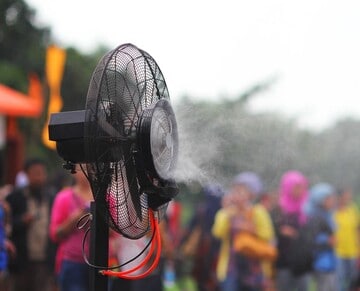
A misting system can be very effective and can reduce the temperature in your outside area by as much as 25F. This type of effective cooling can make all the difference in changing the climate in your outdoor space. From one scorching heat to one, you can enjoy the outdoors on a hot day and remain refreshingly cool.
The disadvantage of misting systems is that they can be fairly expensive to purchase and install. Because some of them have the need to be plumbed into the water system of your home. Other systems will have a connector to the system to connect a hose to provide the water flow.
Another problem is that if you do not have enough water pressure, the misters will not function properly, and the cooling effect will be diminished.
7. Put Down An Outdoor Carpet
An outdoor carpet can be helpful to cool down certain areas of the outdoor area. Outdoor carpets or rugs are designed to be durable and weather-resistant, which allows you to leave them outdoors in most weather conditions.
You could have scattered outdoor carpets in various locations on the floor around areas where you will be walking without shoes on the surface.
Another method is to create a carpet walkway or pathway that you can walk on from the house to the various locations on your deck or patio.
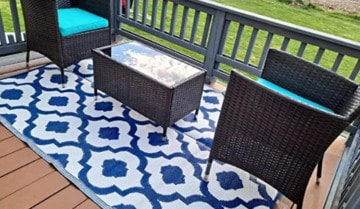
If you have a wood or composite floor, you probably would not want to cover the entire area with outdoor carpet. Still, if you have a concrete floor, this could be an option to keep it cool.
The downside to these outdoor carpets is that they wear out and require frequent cleaning to remain looking good. This may involve cleaning with a vacuum cleaner a few times during your busy outdoor season.
For this reason, it is better to have a few scattered carpets or a roll-up walkway that you can easily pack away or replace rather than cover the entire area in the carpet.
8. Get The Air Moving Outside
Moving air has a cooling effect over any surface that it moves over because it does not allow the heat to settle and become absorbed by the surface. The wind also has the effect of drawing heat out of surfaces, and when it evaporates moisture from the surfaces, the cooling effect is even more pronounced.
Moving air has a cooling effect on people because the air moving across our skin causes any moisture on our skin to evaporate, which cools us down.
This means that getting the air moving across your deck or patio will help cool the area down and make it more enjoyable for you to sit outside, even in the heat of summer! Getting the air moving can be achieved in several ways.
- Don’t block the breeze. Remove any structures blocking the natural breeze to your outside area.
- Roof mount fans. If your outside area has a roof structure, you can install one or more roof mount fans that are very effective in getting the air moving in all directions across your outside area.
- Wall mount fans. Fans mounted to the wall of your house directed towards the outside area will get the air moving nicely, particularly if they are oscillating fans that move from side to side.
- Free-standing fans. Free-standing fan that you can move around offer convenience and a means to limit the air movement to a certain area if that is your requirement.
- Misting fans. Any of the abovementioned fans can be sourced with a misting option. The misting option increases the fan’s cooling effectiveness. You should look into an option if you are looking at getting some fans for your outside area. The misting function usually is selectable, so you can use the fan on its own or use it with the misting process operating for maximum cooling effect.
9. Use Plants To Keep Cool
Plants can be used on your deck or on your patio to bring a delightful cooling effect to the area. Plants work to get a cooling effect by absorbing heat and releasing moisture into the air.
When plants transpire, their leaves release moisture into the atmosphere. This moisture will cool the air area when combined with a light breeze from a natural source or a fan.
Plants scattered around the area’s perimeter will also shade the floor surface, which will prevent the floor from heating up. This strategy does not help too much at midday when the sun is directly overhead, but it will cause the floor surface to cool quicker once it shades over.
Plants provide a cooling effect and add a splash of color and beauty to your outside area. Planting the plants in clay pots will also help to add moisture to the air from the soil in the pots, and they will absorb heat away from the floor of the outside area.
10. Create Your Own Shade
Shade is another way to cool down your outside area very effectively. Again, there is flexibility in the way you can provide shade to the area.
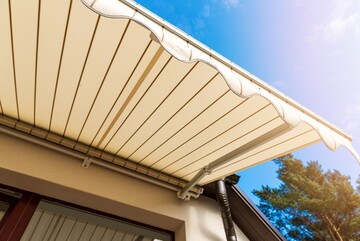
- Use plants in pots. Grow large plants in pots and place them on the deck’s perimeter or patio to cast shade where you need it in the area. You can grow plants that get to the height that you need to provide the shade. Or simply trim the plants to keep them at the desired size.
- Plant trees to provide shade. You can strategically plant trees that will provide shade to portions of the area to give you options of shaded or sunny spots. Planting trees that will lose their leaves in winter will make sure that your outside area is warm in the winter months, which will extend the time you can use the area.
- Install a retractable awning. Retractable awnings can be fitted to the wall of your house so that you can extend them out as far or as little as you like over the deck or patio. The downside of these awnings is that they can be expensive.
- Roll-up side panels. Side panels can be installed to block out the sun and provide shade to areas where you need it. These can be solid panels that provide solid shade or made from materials that provide dappled shade and allow airflow through the panel.
11. Deck Furniture
Deck furniture can also play a role in cooling down your deck or patio area if the right furniture is chosen. Furniture can provide shade over sections of the surface area which can bring a cooling effect.
Light-colored furniture will reduce the heat absorbed by the furniture so that the furniture does not contribute to the heat in the area.
Furniture that promotes airflow through its structure will keep you cool while you sit on it and help not block airflow throughout the space.
Wicker furniture is excellent for this purpose since it does not absorb heat and it allows airflow through its structure. However, furniture made from metal over wood will absorb more heat and become a heat source in the area rather than contribute to the cooling.
What Actually Cools The Deck The Most?
Suppose you cannot choose a suitable cooling method from this list. In that case, you may need to consider what will provide the most effective cooling for your outside area.
In many cases, a combination of methods will offer the best solution to the heat problem on your deck or patio. The most effective methods at providing cooling on their own would be first getting the air moving. Secondly, provide shaded areas over your space at different times of the day. Lastly, use a misting system to introduce a cooling system mist.
Any one of these methods will make a difference to the heat in your outside space, but if you could use them in combination, it increases the cooling effect exponentially.
Conclusion
The summertime is the season where we all want to enjoy the outdoors and use the space outside our homes. A deck or a patio is ideal for making the outdoors an integral part of your home. However, suppose your outside area is too hot in the heat of summer. In that case, you will be unable to make full use of the site in the summer heat and use it to its full potential.
Our Picks based on what we communicated within the article:
Favorite Stain for Wood Decks (pressure treat pine): Cabots Semi solid stain in Cedar
Make a wood deck over your concrete: 27PCS Natural Wood Deck Tiles Interlocking Patio Deck Tiles Solid Wood and Plastic Indoor&Outdoor
A crank out awning: 10′ x 8′ Manual Retractable Awning Sun Shade Shelter for Patio Deck Yard with UV Protection and Easy Crank Opening
Making a few changes to reduce the heat can make a massive difference to the usability of the space and will encourage more frequent use of the area. So try out some of our deck and patio cooling methods and increase the living space of your home for all seasons!
Will Montgomery combines hands-on DIY skills with years of backyard design to help families create cooler, more comfortable outdoor spaces.


